Term archive
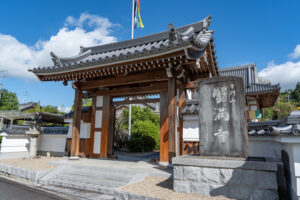
投稿タイプ:sightseeing
Kanimanji Temple
While the exact origins of Kanimanji Temple are shrouded in mystery, it is estimated to have been founded in the end of the Hakuho Period (around 645-710). Larger than it is today, the temple was initially referred to as Kabata-tera in ancient documents.
Its principal image, a colossal 2.2-ton sitting statue of Shaka Nyorai, is a designated National Treasure and a masterpiece surviving from the temple's founding.
The temple is renowned for the story, Kani no Ongaeshi (Crab's Return of a Favor) in the Konjaku Monogatari (Tales of Times Now Past). The story goes as follows:
One day, a young lady who was a devout believer in Kannon (Avalokiteśvara) Bodhisattva saved a crab that was being bullied by villagers. Later, Kannon transformed into a crab and saved her from a terrible fate. Filled with reverence and gratitude, she and her father built the temple to enshrine the crab.
Even now, a crab-releasing festival is held at this temple every year on April 18th.
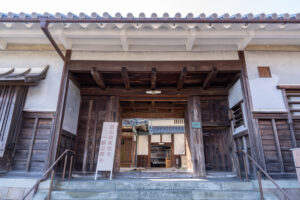
投稿タイプ:sightseeing
The Original Yamada Residence
In the Edo Period (from 1603 to around 1868), the Yamada family served as O-shoya (the head of a local community, who managed the people) of thirteen villages in the area called Mimaki-go. They managed the fishing operations around Ogura-ike Pond that once spread over a large area.
Their residence was strategically built on the stone foundation to protect it from flooding. The nagaya-mon (one of Japanese traditional gatehouse styles) at its entrance, with its imposing appearance reminiscent of a Buke-Yashiki (samurai house), offers a glimpse into the family's former status. The nagaya-mon, the long wall and the main house inside are nationally-registered Tangible Cultural Properties.
You can also see materials related to the Ogura-ike Pond inside. There is an exhibit of traditional fishing tools, including traps and a boat-shaped fish tank as well. The remaining carp-designed ranma (decorative panel seen in the upper part of a room) and a dragon painting on fusuma (Japanese sliding partition) still exude the family’s grandeur.
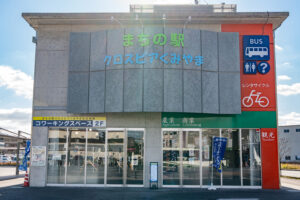
投稿タイプ:sightseeing
Machinoeki Crosspeer Kumiyama
Machinoeki Crosspeer Kumiyama has a bus terminal and a waiting lobby for bus passengers. It’s also used as a public space where people can relax and interact.
They sell local specialties, including fresh local vegetables, food processed in and around the town, and more. A variety of breads are one of the facility’s attractions.
The second floor can be used for meetings, coworking, socializing and other activities.
Electric bicycle rental is available, too. (This is a great place to begin a cycling tour of the town.)
The facility serves as a hub for disseminating information about local industries, facilitating collaboration among local businesses, and so on.

投稿タイプ:sightseeing
Cherry Blossoms Along Tama River
Tama River, located in Ide Town, is a wonderful hanami (cherry-blossom viewing) spot. Cherry trees form elegant rows for approximately 1,500 meters along both banks of the river, and amazing tunnels of cherry blossoms appear in the spring (around late March and early April). In this season, a festival is held to celebrate the fascinating sight. You can even experience the magic of the blossoms illuminated at night.
The gentle flow of the river provides a peaceful atmosphere. It’s a perfect place for families to unwind and enjoy the beauty of nature. It’s also fun to imagine how it was a long time ago when the gentle murmur of waterwheels accompanied the daily lives of people living around the river. Also, adults and children alike can enjoy crossing the river by hopping across the stepping stones.
Tama River is so clear that it is one of the "Selected 100 Exquisite and Well-conserved Waters" of the Heisei Era (1989-2019). Since ancient times, the river has been woven into artworks such as famous poetry, stories and so on.
In this area, you can also see early-blooming cherry blossoms at Ide Town Machizukuri Center Tsubakizaka, and an about 300-year-old cherry tree at Jizozen-in Temple.
Around the Tama River, following the beauty of somei-yoshino (the most popular variety of sakura), yamabuki (Japanese kerria, also known as Japanese rose) flowers bloom, dyeing the surroundings a beautiful rich yellow.
In early summer, you can see fireflies around the river (near Tamamizu Station), too.
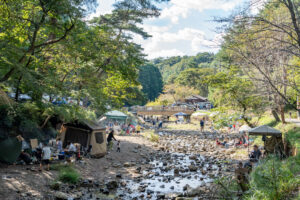
投稿タイプ:sightseeing
Yamashiro Forest Park and Rest Village
This park provides a variety of activities, such as camping in tents, staying in bungalows or log houses, and barbecuing just for the day.
Blessed with abundant nature, this place showcases the beauty of each season, from the lush green in summer to the vibrant fall foliage. The Naruko River flows through the park, where you might encounter freshwater crabs and other creatures. Surrounded by the gentle sounds of the river and the sunlight filtering through the trees, you can relax and unwind.
Mt. Sanjo, located within the park, offers four hiking trails of different levels, allowing you to choose one that suits your fitness. From the observation deck at the summit, you can enjoy a panoramic view of the Soraku area.
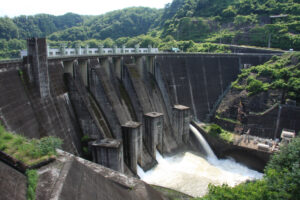
投稿タイプ:sightseeing
Takayama Dam
The dam was constructed in Minamiyamashiro Village in 1968 and began operation the following year. It’s 67 meters high, and stretches approximately 209 meters in length. It has six emergency gates that can be opened simultaneously to flush the water.
With abundant nature, this area is a good destination for driving and hiking. In the spring, you can see beautiful cherry blossoms. Around the middle of the dam’s reservoir, there is Tsukigase Baikei (Tsukigase Plum Valley) that is one of the “Places of Scenic Beauty” of Japan. It’s famous for its amazing plum blossoms. Uniquely, the reservoir spans across three prefectures: Kyoto, Nara, and Mie. Nearby, you can also find Tayama Tsurugi Tea Plantation. Recognized as a part of the Japan Heritage, it presents a culturally significant landscape.
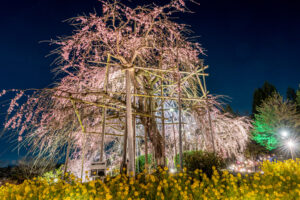
投稿タイプ:sightseeing
Uji City Botanical Park
Uji City Botanical Park opened in October 1996. The spacious grounds, spanning approximately 10 hectares, feature a varied landscape with undulating terrain, a fountain, a pond, and streams that create beautiful scenery together with the plants.
The large-scale multi-level flower bed, Tapestry of Flowers and Water, is the largest in Japan, offering an impressive sight measuring 62 meters in width and 18 meters in height. 3,675 planters are arranged on the 46 tiers of the grand platform at the waterside, depicting characters and other themes related to Uji, seasonal motifs, and so on.
On the southwest (left) side of the park lies the Spring Zone, where cherry blossoms and various other flowers bloom. The weeping cherry blossoms are particularly popular, reaching full bloom around late March, and the nightly light-up (free of charge) is eagerly anticipated by many people every year. Visitors can enjoy the stunning view with the city nightscape.
In summer, fireflies can be seen around a stream. Additionally, the Summer Zone offers a display of lotus flowers, which once flourished on Ogura-ike Pond that once existed.
The northeast (right) side of the park boasts the Fall Zone, where visitors can admire beautiful fall foliage.
The greenhouse provides an environment to enjoy tropical and subtropical plants throughout the year, along with the waterfall.

投稿タイプ:sightseeing
Manpuku-ji Temple
Obaku-san Manpuku-ji is the head temple of the Obaku sect of Zen Buddhism. In 2024, three of its buildings, including the main hall, were designated as National Treasures.
This temple was founded in 1661 by Ingen Ryuki (Yinyuan Longqi), a Chinese Zen Buddhist priest who came to Japan in 1654.
He introduced not only Zen Buddhism but also many things and cultural elements to Japan, such as ingen (common beans) and lotus roots.
One of them, Fucha Ryori (Chinese Buddhist cuisine), can actually be enjoyed at the temple (reservations required). It is characterized by its diverse offerings, with some artfully mimicking other foods, like one that resembles eel. It is fun to experience Chinese culture through food.
Also, the Chinese-style sutra chanting called Bonbai sounds like a song.
The precincts, with their historic buildings, are filled with a Chinese atmosphere. Other impressive sights include the Kaipan (wooden fish board), said to be the original form of mokugyo (a percussion instrument used to keep rhythm during sutra chanting), the golden statue of a deity Hotei Son (Budai), and the statue of Ragora Sonja (Rahula), from whose chest the face of Buddha emerges.

投稿タイプ:sightseeing
Ujikami Shrine
Ujikami Shrine is one of the World Heritage sites. It was once a single shrine together with Uji-Shrine, as a guardian shrine for Byodoin Temple.
The main hall (a National Treasure), built in the late Heian Period (794-1185), is the oldest existing shrine building in Japan. Built in the Nagare-zukuri style characterized by its long, flowing roof, it houses three structures to enshrine deities, which are two larger shrines flanking a smaller one in the center.
The worship hall (a National Treasure) is part of a building constructed in the Shinden-zukuri, the representative architectural style of aristocratic residences in the Heian Period.
The enshrined deities are Emperor Ojin, Uji no Wakiiratsuko, and Emperor Nintoku.
Ujikami Shrine offers charming rabbit omamori (Japanese amulets), omikuji (small items containing fortune-telling slips), and so on.
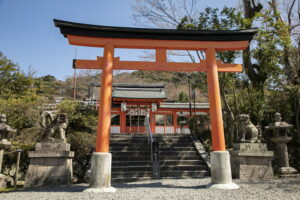
投稿タイプ:sightseeing
Uji-Shrine
Uji-Shrine was established in 313 on the right bank of the Uji River. The current main hall (an Important Cultural Property) was built in the Kamakura Period (1185-1333). Built in the architectural style called Sangensha Nagare-zukuri, it has a large roof and a facade with four pillars (creating three spaces). The shrine also preserves other various cultural properties, such as the oldest existing wooden komainu (a pair of guardian creatures called lion-dogs in colloquial English) and a valuable mask used in nō (a classical Japanese performing art).
The enshrined deity is Uji no Wakiiratsuko, believed to be a deity of academic achievement and success in entrance exams. This area was once home to Kirihara-Higeta-no-Miya, the detached palace of Emperor Ojin and the residence of his son, Uji no Wakiiratsuko.
Legend has it that when Uji no Wakiiratsuko lost his way, a rabbit appeared and guided him, looking back repeatedly to ensure he was following. According to one theory, this is the origin of the place name Uji (rabbit path). At Uji-Shrine, Mikaeri Usagi (looking-back rabbit), a messenger of a deity, guiding people to the right direction, is worshipped. There is a temizuya (place to purify hands with water) with a rabbit motif, cute rabbit omikuji (small items containing fortune-telling slips) and ema (small plaques to write wishes), and so on.
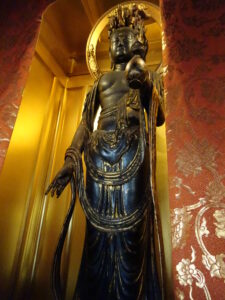
投稿タイプ:sightseeing
Omido Kannonji Temple
Omido Kannonji Temple is located in Kyotanabe City in the Kyoto Tea Country region. The temple is believed to have been founded over 1,300 years ago at the request of Emperor Tenmu. It has suffered from numerous fires throughout its history, and most of its 13 halls and more than 20 living quarters of monks were lost in the fire in 1437. Only the Omido (the main hall) was rebuilt later, and it survives to this day. (It was last rebuilt in 1953.)
The temple is dedicated to Kannon (Avalokiteśvara) Bodhisattva. The statue of Eleven-Headed Kannon Bodhisattva is created with sophisticated techniques by layering using lacquer repeatedly, and the surface is finished with gold leaves. It is one of seven statues of Eleven-Headed Kannon Bodhisattva designated as National Treasures.
In spring, yellow carpets of rapeseed blossoms spread out in front of the temple, which is a spectacular sight. You can also see beautiful cherry blossoms on the approach to the temple.
In autumn, the main hall and garden are beautiful with fall foliage. A nighttime illumination event is held every year, in which visitors can enjoy the fall colors with the traditional Japanese ambiance.
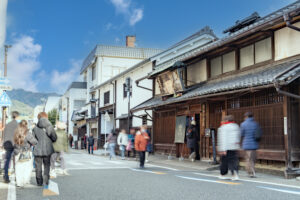
投稿タイプ:sightseeing
Ujibashi Street
Ujibashi Street is one of the main streets leading from JR Uji Station to Byodoin Temple. This street preserves old buildings including long-established shops of tea farmers and tea manufacturers. The street also boasts a vibrant mix of restaurants, cafes, bakeries, sweet shops, a supermarket, and many more. Not just tourists, but locals also enjoy shopping and dining here. The street leads to Uji River, and before Uji-bashi Bridge is a popular photo spot with a statue of Murasaki Shikibu, the author of The Tale of Genji.
